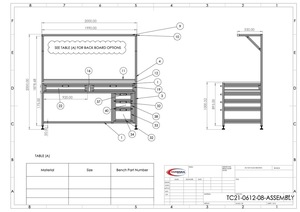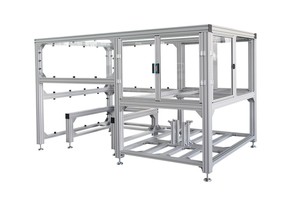
 |
Charlotte Stonestreet
Managing Editor |
| Home> | MACHINE BUILDING & ENGINEERING | >Machine Frameworks | >It’s a frame up! |
It’s a frame up!
17 April 2025
Luke Wilkinson assesses the options when it comes to the design and build of aluminium frames for industrial use
METAL FRAMES are used extensively across industry, for everything from machine guarding to machine substructures. Wherever you have a machine or process that needs added stability, you are likely to find a metal frame that carries the weight or acts as a supporting structure.
Frames are mostly made from aluminium extrusions or steel. Aluminium extrusions are lightweight yet strong, non-magnetic and naturally rust resistant (although corrosion may occur when exposed to water and oxygen), making them very popular in industrial settings. Steel remains a suitable option for certain applications and industries, but requires welding and drilling which is expensive, time consuming, and difficult to alter if plans should change.
If, like most companies, you go down the aluminium route, who designs and constructs the frames is the big question. Do you opt for supply of the aluminium extrusion only and then build the frame in house, or do you outsource the design and build and have the finished frame delivered ready to use? At Matara, we do both, so have a good insight into the pros and cons of both approaches.
Why build your own frame?
If price is the determining factor in your project, then building your own frame is one helpful means of keeping costs down. You can choose from a wide range of aluminium profiles which can be cut to your required lengths and can be precision drilled to your specifications, making frame construction that bit easier. Ensuring the supplier also stocks off the shelf accessories that are designed to work with one another will enable you to configure your frame the way you want it.
Once you have all the parts you need, constructing the frame requires some time, patience and space. If your frame is relatively simple and you're buying everything cut to size and machined already, then you should be able to get the job done relatively swiftly with a basic set of hand tools, such as a 5mm allen key and tape measure. However, if you have no experience, then designing and building your own frame is going to be a steep learning curve initially. It’s also going to take time, so do factor that in.
If you do choose this option, please be sure to check you are ordering the right size and type of aluminium extrusion connectors, aluminium extrusion brackets, and accessories, which is an all too common mistake. If you’ve purchased the wrong accessories, the only way to get them to work as part of your frame is machine them or buy new parts, both of which add to the end bill.
Outsourcing
If you employ the services of an experienced aluminium extrusion frame builder, such as Matara, you benefit from an in-house CAD team and dedicated engineers who have vast experience in designing and building aluminium frames to ensure that you get the right aluminium frame for your requirements. This can be for straightforward through to highly complex frames that require bespoke tooling.
Although there is clearly an added cost for frame production, you may be pleasantly surprised to find the cost much lower than expected. That’s because specialist companies have the experience and tools to enable them to build a frame very quickly.
The process is straightforward. If you have the means, supply a CAD style drawing of what you want to produce (although a hand-drawn sketch can suffice). This drawing doesn’t have to be hugely detailed, as long as it includes the box-section pieces, and their length and size, plus an indication of if there's going to be panel materials included and where. It’s also very helpful to explain what the frame is going to be used for. If the drawing supplied is too simplistic, the company will more than likely produce its own drawing and send it back to you to ensure it meets your needs.
When sign off is received, the process starts with cutting and preparing the lengths, and cutting angled sections if these are needed. Once the required sections are cut and machined, all aluminium is deburred and cleaned down ready for the next stage which is machining and processes, such as drilling holes, tapping, milling, cut-outs, etc. From here the process goes to sheet materials, where polycarbonate or wire mesh is cut to size, should these be included in the design. The finished frame can then be delivered to site either flat packed for you to assemble, or fully pre-assembled and ready to use. The majority of Matara customers opt for that latter, which is more convenient for them and provides an added layer of inspection.
Think ahead
Whether you opt for in-house design and build or outsource to a third party, it’s best to think well ahead when it comes frame making.
If you are outsourcing, then be aware that although frames can be produced quickly, most companies in this field have lead times of five to six weeks so place your order well before you need it. Also, when you are placing your order, don’t wait until your design is close to completion to ask for advice, especially if it is multi-functional and therefore complex frame. If your design has taken the wrong path, there’s a chance you may have to start from scratch as not all designs can be rectified.
Regardless of who is making the frame, be sure to avoid last minute changes to the frames as it could compromise the outcome and delay delivery. Adding one extra bar to a frame, for example, might not seem a big deal, but it requires all the drawings to be amended and the bill of materials – which can be in the hundreds, if not thousands of quantities of parts – to be gone through to identify all of the parts that are affected by that change and adjusted accordingly. Furthermore, once the frame has been produced, any changes to it may compromise the quality of the finish as aluminium is soft and therefore easily scratched.
Luke Wilkinson is design and product development manager at Matara
- Specifying a linear actuator: 3 key factors
- Precision XY linear system
- Matara appoints new business development managers
- Linear actuator range expanded
- Coated linear rail and ballscrews for demanding applications
- Don't drop the ball!
- Matara welcomes new business development managers
- Matara launches first pneumatics product catalogue
- Matara pneumatic and linear automation components on show
- Linear actuator catalogue features new product lines





















